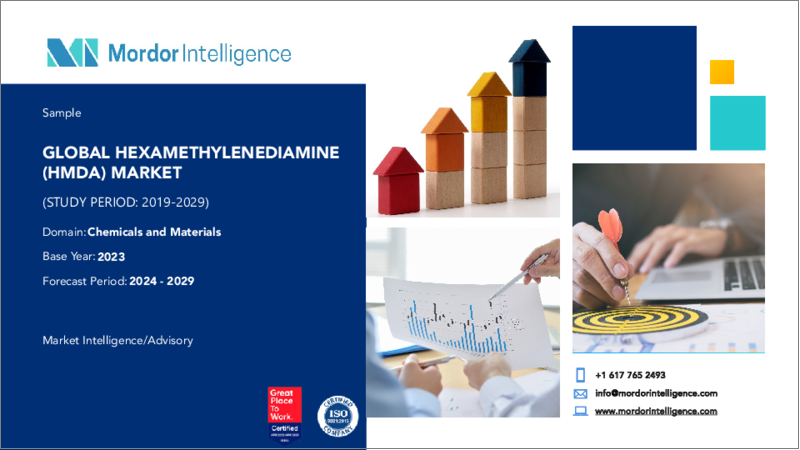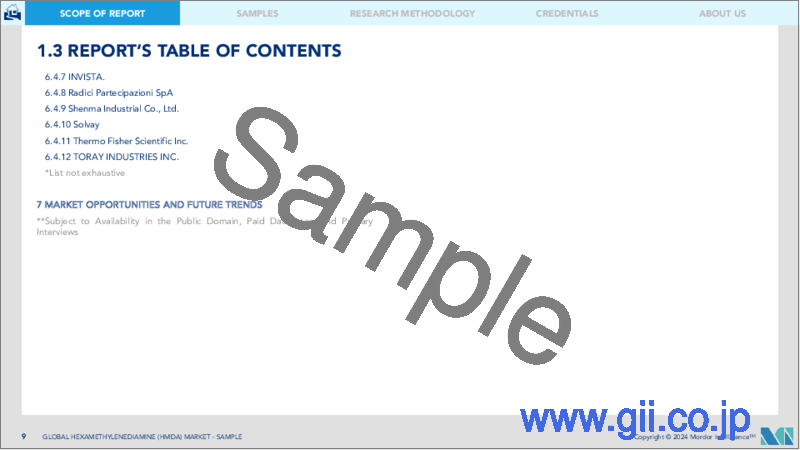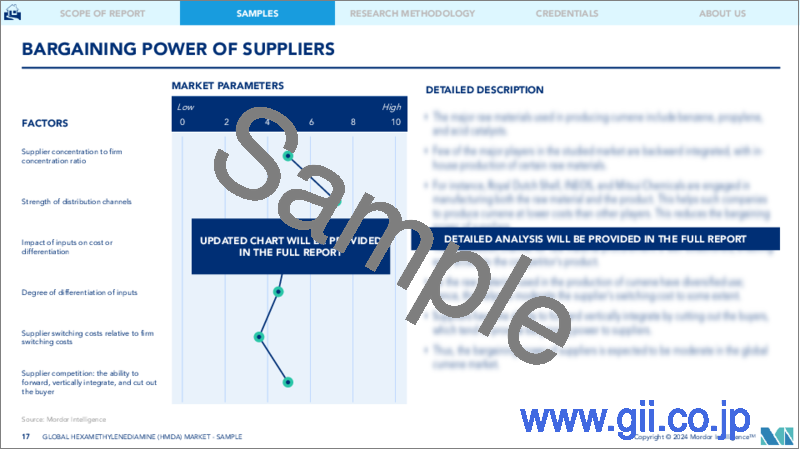|
|
市場調査レポート
商品コード
1404057
ヘキサメチレンジアミン:市場シェア分析、産業動向と統計、2024年~2029年の成長予測Hexamethylenediamine - Market Share Analysis, Industry Trends & Statistics, Growth Forecasts 2024 - 2029 |
||||||
|
● お客様のご希望に応じて、既存データの加工や未掲載情報(例:国別セグメント)の追加などの対応が可能です。 詳細はお問い合わせください。 |
|||||||
| ヘキサメチレンジアミン:市場シェア分析、産業動向と統計、2024年~2029年の成長予測 |
|
出版日: 2024年01月04日
発行: Mordor Intelligence
ページ情報: 英文 120 Pages
納期: 2~3営業日
|
- 全表示
- 概要
- 目次
ヘキサメチレンジアミンの市場規模は2024年に140万トンと推計され、2029年には173万トンに達し、予測期間(2024年~2029年)のCAGRは4%を超える成長が見込まれています。
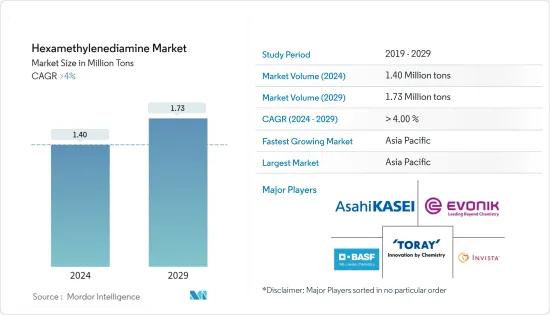
COVID-19パンデミックはヘキサメチレンジアミン市場にマイナスの影響を与えました。いくつかの国で全国的な封鎖が行われ、社会的遠ざけ策による労働力不足が自動車用車両の製造拠点の停止を招き、ヘキサメチレンジアミン市場に影響を与えました。しかし、COVID流行後は、繊維および自動車エンドユーザー業界からの需要増加により、ヘキサメチレンジアミン市場は順調に回復しました。
主なハイライト
- ナイロン66樹脂の消費量の増加と、自動車産業および繊維産業におけるヘキサメチレンジアミン需要の増加が、ヘキサメチレンジアミン市場を牽引すると予想されます。
- ナイロン製造工程の代替原料としてのヒマシ油の使用は、市場成長の妨げになると予想されます。
- バイオベースのヘキサメチレンジアミン製品に対する需要の増加は、予測期間中に市場に機会をもたらすと予想されます。
- アジア太平洋地域は、繊維および自動車エンドユーザー産業からのヘキサメチレンジアミン需要の高まりにより、市場を独占すると予想されます。
ヘキサメチレンジアミン市場の動向
繊維エンドユーザー産業が市場を独占する
- ヘキサメチレンジアミンはナイロン66の製造に大量に消費されます。ナイロン66は、それぞれ6個の炭素原子を含む2種類のモノマー、ヘキサメチレンジアミンとアジピン酸からできています。ナイロン66は繊維産業で広く使用されています。
- ナイロン66は、より優れた耐久性と耐引裂性を備えた布地の製造に使用されます。ナイロンベースの生地は、さまざまな用途やアウトドア用品のテキスタイルの補強に使用されています。
- アジア太平洋と欧州は、世界最大の繊維市場です。欧州委員会によると、EUの繊維エコシステムは価値を生み出し、投資と技術革新の機会を提供しています。繊維・衣料(T&C)は欧州最大かつ最も多角的な産業部門のひとつであり、150万人の労働力を擁しています。
- Apparel Resourcesによると、2022年、EUの繊維・衣料品市場は2,000億ユーロ(2,170億米ドル)の売上を記録しました。今後数年でさらに増加すると予想されています。このため、繊維製品市場の拡大が、同地域におけるヘキサメチレンジアミンの需要を牽引すると予想されます。
- 同様に、世界貿易機関(WTO)によると、2022年には中国が世界の繊維製品輸出国の首位となり、その額は約1,480億米ドルに上った。同様に、欧州連合(EU)は約710億米ドルの輸出額で第2位でした。繊維製品の輸出額は今後さらに増加すると予想され、現在の研究市場を牽引しています。
- 例えばインドでは、過去10年間から繊維産業への外国直接投資(FDI)が増加し、繊維製品の生産が増加しているため、フロック接着剤の使用が増加しています。インド・ブランド・エクイティ財団によると、インドの繊維・アパレル産業は2025-26年までに1,900億米ドルに達すると予想されています。
- このため、予測期間中、繊維エンドユーザー産業セグメントがヘキサメチレンジアミン市場を独占するとみられます。
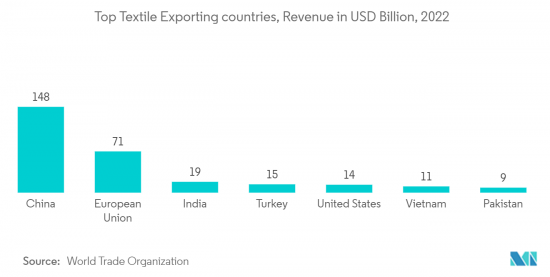
アジア太平洋地域が市場を独占する
- アジア太平洋地域は、繊維、自動車、プラスチックのエンドユーザー産業からの需要増加により、ヘキサメチレンジアミン市場を独占すると予想されます。
- 繊維産業ではナイロン繊維の使用量が増加しており、今後数年間にわたり同地域のヘキサメチレンジアミン市場を牽引することが期待されます。アジア太平洋地域は、中国の繊維セクターが高度に発展していることと、自動車セクターへの継続的な投資により、世界市場を独占すると予想されます。
- この地域では、中国とバングラデシュが繊維製品の最大市場です。中国国家統計局によると、中国の繊維生産量は前年同期の235億メートルに対し、2022年には382億メートルに達しました。このように、繊維製品の生産量の増加は、現在の研究市場を牽引すると予想されます。
- バングラデシュはこの地域で2番目に大きな繊維製品市場です。World Trade Statistical Review 2023によると、同国は2022年に450億米ドルの繊維製品を輸出しました。世界の衣料品輸出における同国のシェアは、前年の6.4%から2022年には7.9%に上昇しました。したがって、繊維市場の成長は、同国のヘキサメチレンジアミン市場を牽引すると思われます。
- 燃費向上と排出ガス低減のために自動車の軽量化が重視されているため、自動車のボンネット下部品では軽量複合ナイロン樹脂の需要が増加します。中国はこの地域最大の自動車メーカーです。OICA(The Organisation Internationale des Constructeurs d'Automobiles)によると、中国の自動車生産台数は2022年に合計2,702万台に達し、同時期の前年比3%増となった。
- 同様に、インドは同地域で第2位の自動車メーカーとなった。OICAによると、2022年の自動車生産台数は545万台に達し、2021年の439万台から24%の伸びを示しました。
- さらに、インドでの需要拡大に対応するため、様々なメーカーが同国での自動車生産能力を増強する拡張計画を発表しています。例えば、MG Motor Indiaは2023年1月に1億米ドルを投資して生産能力を拡大し、2023年末までに70%の成長を記録すると発表しました。このように、自動車生産台数の増加がナイロン繊維市場を牽引し、現在の研究市場を押し上げると予想されます。
- 全体として、繊維産業や自動車エンドユーザー産業といった産業の成長が、予測期間中、この地域のヘキサメチレンジアミン市場を牽引すると思われます。
ヘキサメチレンジアミン産業の概要
ヘキサメチレンジアミン市場は、その性質上、部分的に統合されています。市場の主要企業(順不同)には、BASF SE、旭化成、Evonik Industries AG、TORAY INDUSTRIES INC.、インビスタなどがあります。
その他の特典:
- エクセル形式の市場予測(ME)シート
- 3ヶ月間のアナリスト・サポート
目次
第1章 イントロダクション
- 調査の前提条件
- 調査範囲
第2章 調査手法
第3章 エグゼクティブサマリー
第4章 市場力学
- 促進要因
- ナイロン66樹脂の消費拡大
- 自動車産業と繊維産業におけるヘキサメチレンジアミン需要の増加
- その他の促進要因
- 抑制要因
- ナイロン製造におけるバイオベース原料の使用増加
- その他の阻害要因
- 産業バリューチェーン分析
- ポーターのファイブフォース分析
- 供給企業の交渉力
- 買い手の交渉力
- 新規参入業者の脅威
- 代替品の脅威
- 競合の程度
第5章 市場セグメンテーション(市場規模)
- 用途
- ナイロン生産
- コーティング中間体
- 殺生物剤
- その他の用途(硬化剤、潤滑剤など)
- エンドユーザー産業
- 繊維
- プラスチック
- 自動車産業
- その他のエンドユーザー産業(塗料・コーティング、石油化学など)
- 地域
- アジア太平洋
- 中国
- インド
- 日本
- 韓国
- その他のアジア太平洋
- 北米
- 米国
- カナダ
- メキシコ
- 欧州
- ドイツ
- 英国
- イタリア
- フランス
- その他の欧州
- 南米
- ブラジル
- アルゼンチン
- その他の南米
- 中東・アフリカ
- サウジアラビア
- 南アフリカ
- その他の中東・アフリカ
- アジア太平洋
第6章 競合情勢
- M&A、合弁事業、提携、協定
- 市場シェア(%)**/ランキング分析
- 主要企業の戦略
- 企業プロファイル
- Alfa Aesar
- Asahi Kasei Corporation
- Ascend Performance Materials
- BASF SE
- DOW
- Evonik Industries AG
- Genomatica Inc.
- INVISTA
- Radici Partecipazioni SpA
- Shenma Industrial Co., Ltd.
- Solvay
- TORAY INDUSTRIES INC.
第7章 市場機会と今後の動向
- バイオベースのヘキサメチレンジアミン製品に対する需要の増加
- その他の機会

The Hexamethylenediamine Market size is estimated at 1.40 Million tons in 2024, and is expected to reach 1.73 Million tons by 2029, growing at a CAGR of greater than 4% during the forecast period (2024-2029).
The COVID-19 pandemic negatively affected the market for hexamethylenediamine. The nationwide lockdowns in several countries and the labor shortage due to social distancing measures resulted in the suspension of manufacturing sites for automotive vehicles, which affected the market for hexamethylenediamine. However, post-COVID pandemic, the market for hexamethylenediamine recovered well due to increasing demand from textile and automotive end-user industries.
Key Highlights
- The increasing consumption of Nylon 66 resins and the rising demand for hexamethylenediamine in the automotive and textile industries are expected to drive the market for Hexamethylenediamine.
- The usage of castor oil as an alternative raw material for the nylon production process is expected to hinder market growth.
- The increasing demand for bio-based hexamethylenediamine products is expected to create opportunities for the market during the forecast period.
- The Asia-Pacific region is expected to dominate the market due to the rising demand for hexamethylenediamine from textile and automotive end-user industries.
Hexamethylenediamine Market Trends
Textile End-User Industry to Dominate the Market
- A high amount of hexamethylenediamine produced is consumed for the manufacturing of nylon 66. Nylon 66 is made of two monomers, each containing six carbon atoms, hexamethylenediamine and adipic acid. The nylon 66 is widely used in the textile industry.
- Nylon 66 is used to manufacture fabric materials that provide better durability and tearing resistance. The nylon-based fabrics are used for various applications and reinforcement for outdoor equipment textiles.
- Asia-Pacific and Europe are the largest markets for textiles across the globe. According to the European Commission, The EU's textiles ecosystem generates value and opens up opportunities for investment and innovation. Textiles and clothing (T&C) is one of Europe's largest and most diversified industrial sectors, with a workforce of 1.5 million.
- According to Apparel Resources, in 2022, the textile and clothing market in the European Union registered EUR 200 billion (USD 217 billion) in revenue. It is further expected to increase in the coming years. Thus, the increasing market for textile products is expected to drive the demand for hexamethylenediamine in the region.
- Similarly, according to the World Trade Organization, in 2022, China was the top-ranked global textile exporter, with a value of approximately USD 148 billion. Similarly, the European Union ranked in second place, with an export value of around USD 71 billion. The export value of textiles is further expected to increase in the coming years, thereby driving the current studied market.
- For instance, in India, with an increase in foreign direct investment (FDI) in the textile industry from the past decade, the production of textiles is increasing, thus resulting in increased use of flock adhesives. According to the Indian Brand Equity Foundation, India's textile and apparel industry is expected to reach USD 190 billion by 2025-26.
- Thus, the textile end-user industry segment will dominate the market for hexamethylenediamine during the forecast period.

Asia-Pacific to Dominate the Market
- The Asia-Pacific region is expected to dominate the market for hexamethylenediamine due to rising demand from the textile, automotive, and plastics end-user industries.
- The increasing usage of nylon fibers is increasing in the textile industry expected to drive the market for hexamethylenediamine in the region through the years to come. Asia-Pacific is expected to dominate the global market, owing to the highly developed textile sector in China, coupled with continuous investments in the automotive sectors.
- China and Bangladesh are the largest markets for Textiles in the region. According to the National Bureau of Statistics of China, the textile production volume in China accounted for 38.2 billion meters in 2022, compared to 23.5 billion meters during the same period in the previous year. Thus, the increase in the production volume of textiles is expected to drive the current studied market.
- Bangladesh is the second-largest market for textiles in the region. According to the World Trade Statistical Review 2023, the country exported textiles worth USD 45 billion in the year 2022. The country's share in global clothing exports increased to 7.9% in the year 2022, as compared to 6.4 % registered in the previous year. Thus, the growth in the textile market will drive the market for hexamethylenediamine in the country.
- The focus on reducing vehicle weight for greater fuel efficiency and lower emissions will increase the demand for lightweight composite nylon resins in automotive under-the-hood components. China is the largest automotive vehicle manufacturer in the region. According to OICA (The Organisation Internationale des Constructeurs d'Automobiles), automotive vehicle production in China reached a total of 27.02 million units in 2022, an increase of 3% over the previous year for the same period.
- Similarly, India has become the second-largest automotive vehicle manufacturer in the region. According to OICA, the total production volume of automotive vehicles reached 5.45 million units in 2022, indicating a growth of 24% as compared to 4.39 million units registered in 2021.
- Furthermore, to meet the growing demand in India, various manufacturers have announced their expansion plans to increase the production capacity of automotive vehicles in the country. For instance, in January 2023, MG Motor India announced to invest USD 100 million to expand capacity and register a growth of 70% by the end of 2023. Thus, an increase in automotive vehicle production is expected to drive the market for nylon fibers, thereby driving the current studied market.
- Overall, the growth in industries such as textile and automotive end-user industries is likely to drive the market for hexamethylenediamine in the region during the forecast period.
Hexamethylenediamine Industry Overview
The hexamethylenediamine market is partially consolidated in nature. Some of the major players in the market (not in any particular order) include BASF SE, Asahi Kasei Corporation, Evonik Industries AG, TORAY INDUSTRIES INC., and INVISTA, among others.
Additional Benefits:
- The market estimate (ME) sheet in Excel format
- 3 months of analyst support
TABLE OF CONTENTS
1 INTRODUCTION
- 1.1 Study Assumptions
- 1.2 Scope of the Study
2 RESEARCH METHODOLOGY
3 EXECUTIVE SUMMARY
4 MARKET DYNAMICS
- 4.1 Drivers
- 4.1.1 Increasing Consumption of Nylon 66 Resins
- 4.1.2 The Rising Demand for Hexamethylenediamine in Automotive and Textile Industries
- 4.1.3 Other Drivers
- 4.2 Restraints
- 4.2.1 Increased Usage of of Bio-based Raw Materials for Nylon Production
- 4.2.2 Other Restraints
- 4.3 Industry Value Chain Analysis
- 4.4 Porter's Five Forces Analysis
- 4.4.1 Bargaining Power of Suppliers
- 4.4.2 Bargaining Power of Buyers
- 4.4.3 Threat of New Entrants
- 4.4.4 Threat of Substitute Products and Services
- 4.4.5 Degree of Competition
5 MARKET SEGMENTATION (Market Size in Volume)
- 5.1 Application
- 5.1.1 Nylon Production
- 5.1.2 Intermediate for Coatings
- 5.1.3 Biocides
- 5.1.4 Other Applications (Curing Agents, Lubricants, etc.)
- 5.2 End-user Industry
- 5.2.1 Textile
- 5.2.2 Plastics
- 5.2.3 Automotive
- 5.2.4 Other End-user Industries (Paints and Coatings, Petrochemicals, etc.)
- 5.3 Geography
- 5.3.1 Asia-Pacific
- 5.3.1.1 China
- 5.3.1.2 India
- 5.3.1.3 Japan
- 5.3.1.4 South Korea
- 5.3.1.5 Rest of Asia-Pacific
- 5.3.2 North America
- 5.3.2.1 United States
- 5.3.2.2 Canada
- 5.3.2.3 Mexico
- 5.3.3 Europe
- 5.3.3.1 Germany
- 5.3.3.2 United Kingdom
- 5.3.3.3 Italy
- 5.3.3.4 France
- 5.3.3.5 Rest of Europe
- 5.3.4 South America
- 5.3.4.1 Brazil
- 5.3.4.2 Argentina
- 5.3.4.3 Rest of South America
- 5.3.5 Middle East and Africa
- 5.3.5.1 Saudi Arabia
- 5.3.5.2 South Africa
- 5.3.5.3 Rest of Middle East and Africa
- 5.3.1 Asia-Pacific
6 COMPETITIVE LANDSCAPE
- 6.1 Mergers and Acquisitions, Joint Ventures, Collaborations, and Agreements
- 6.2 Market Share (%)**/Ranking Analysis
- 6.3 Strategies Adopted by Leading Players
- 6.4 Company Profiles
- 6.4.1 Alfa Aesar
- 6.4.2 Asahi Kasei Corporation
- 6.4.3 Ascend Performance Materials
- 6.4.4 BASF SE
- 6.4.5 DOW
- 6.4.6 Evonik Industries AG
- 6.4.7 Genomatica Inc.
- 6.4.8 INVISTA
- 6.4.9 Radici Partecipazioni SpA
- 6.4.10 Shenma Industrial Co., Ltd.
- 6.4.11 Solvay
- 6.4.12 TORAY INDUSTRIES INC.
7 MARKET OPPORTUNITIES AND FUTURE TRENDS
- 7.1 Increasing Demand for Bio-Based Hexamethylenediamine Products
- 7.2 Other Opportunities
